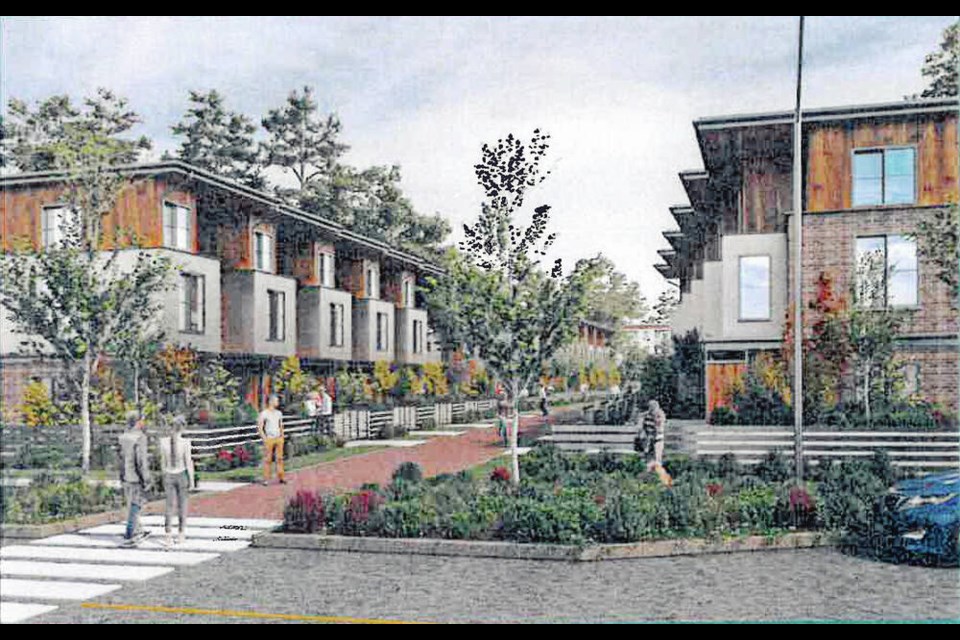Most speakers at a public hearing on a proposed mixed-use village-style development in Lantzville told council that the project does not fit in with their vision for the community.
Project critics said the Village South plan is too big, too dense, too costly for taxpayers and does not comply with the 2019 Official Community Plan that was developed in consultation with residents.
They were backed up by a petition with just over 1,100 signatures opposing the project in its current form.
Lantzville is a community of 3,817 residents and 1,568 private homes, according to the latest census. It lies between Parksville to the north and borders Nanaimo on the south.
Developer Lantzville Projects Ltd. is proposing to build about 730 units in a variety of housing types on 23.3 hectares.
Housing options include townhomes and patio homes, single-family houses, multifamily units, and possibly seniors supportive housing.
The proposal includes a commercial area, space for a grocery store, parks, a network of trails, a playing field, rain gardens, one hectare of land for public use such as a community centre, and a pedestrian friendly streetscape.
A public hearing was held on April 13 on the developer’s bid to amend the Official Community Plan and the zoning bylaw to allow Village South to move forward.
May 4 is the tentative date for council to vote on whether to approve third reading.
Evan Peterson, of Barefoot Planning of Victoria, spoke for the developer saying the current council had earlier amended its zoning to create an incentive for a new plan for a “viable and vibrant village consistent with the OCP.”
Lantzville Project’s proposal would do just that and it reflects the community’s vision and goals, Peterson said.
The plan would set out guidelines for future applications for the village which would come to council at the development permit stage when details would be decided. Exact types of buildings or road alignment might change for example in that process, he said.
Cluster housing and small homes suitable for downsizing seniors or first-time homebuyers are envisioned, Peterson said. A village core could see small-scale mixed use, with retail or commercial on the ground level, topped by residential or office space.
The numbers of anticipated housing units outlined in the current OCP do not set out density maximums, he said. Rather, they are a general idea of what might be anticipated. These numbers are “very outdated and they are not based on any good planning principles that I can attest to.”
Housing numbers are a key concern of critics, who favour the 390 units in the OCP over the developer’s proposal for about 730 homes. Peterson considers 730 units a minimum.
Another 100 seniors’ supportive units are also set out in the community plan.
From an environmental standpoint, compact, walkable communities are needed rather than sprawling bedroom communities, Peterson said. This would allow for more rural and natural areas to be protected.
“This is the time for council to make brave decisions in the face of aggressive opposition,” which is “founded on misinformation, scare tactics and intimidation,” he said.
Opponent Joan Jones described the proposal as a “massive development.”
Residents value Lantzville’s quiet lifestyle and semi-rural character, said Jones, who helped collect signatures for the petition.
John Jones is concerned about the proposed location of a possible community centre. A geotechnical report found that the site is the least-suitable location for a building because of the nature of its soil and drainage.
Roger Belanger said the developer’s housing numbers goes “against the character of Lantzville”and he had not heard a strong rationale to justify the higher number of units.
Luke McLeod echoed concerns about density. “I’m not against development in Lantzville. Development is inevitable.” But the OCP number of 389 and the 100 seniors’ supportive living units were adopted after extensive community consultation and guidance by both expert planners and facilitators, he said. “We want the numbers listed in the OCP. Not more.
“The province has also made it clear that they want each community to do its part in contributing to the housing stock and that is exactly what the numbers in the OCP accomplish.”
Also, the provincial housing policy supports zoning that would include affordable housing, and seniors assisted living and rental units, McLeod said. “None of these are guaranteed in the proposal.”
Ruth Abramsom said anyone familiar with the Lower Mainland knows that building more densely and building more variety does not equal obtainable, nor affordable housing. “The presumption that increasing supply decreases costs is only true if demand is limited and it never has been in my adult life.”
Housing costs have gone up and are less affordable for working people than prior to redevelopments, Abramsom said.
Along with several other speakers, she feared the community will face higher taxes through this kind of project because of costs such as administration, maintenance and policing.
cjwilson@timescolonist.com



